Report on Entrepreneurial Ventures: Types, Impact, and Significance
VerifiedAdded on 2022/11/23
|9
|2229
|372
Report
AI Summary
This report delves into the realm of entrepreneurial ventures, offering a comprehensive analysis of their diverse types and their relative significance in the UK economy. Part one of the report explores various entrepreneurial ventures such as lifestyle, survival, aggressive growth, and managed growth, highlighting their unique characteristics, operational strategies, and financial models. It also provides a comparative analysis of different venture types including private, public, and social ventures, along with micro, small, and medium-sized enterprises. Furthermore, the report emphasizes the substantial impact of micro and small businesses on the UK economy, including their contribution to job creation and economic growth. The significance of small businesses and start-ups within the social economy is also examined, emphasizing their role in addressing social and environmental challenges. Part two of the report contains the conclusion. The report uses various sources like journals and books to support the findings.

9
Paraphrase This Document
Need a fresh take? Get an instant paraphrase of this document with our AI Paraphraser
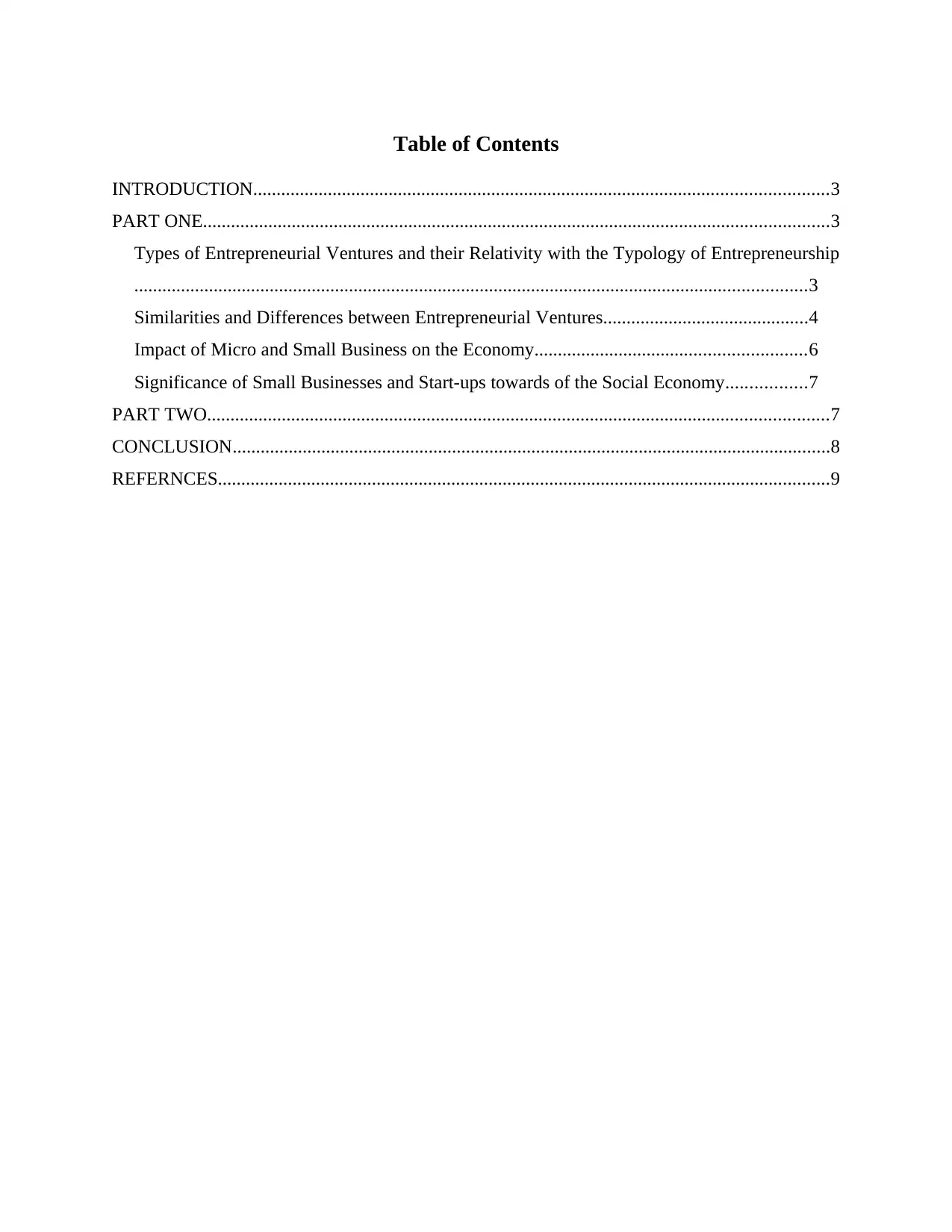
Table of Contents
INTRODUCTION...........................................................................................................................3
PART ONE......................................................................................................................................3
Types of Entrepreneurial Ventures and their Relativity with the Typology of Entrepreneurship
................................................................................................................................................3
Similarities and Differences between Entrepreneurial Ventures............................................4
Impact of Micro and Small Business on the Economy..........................................................6
Significance of Small Businesses and Start-ups towards of the Social Economy.................7
PART TWO.....................................................................................................................................7
CONCLUSION................................................................................................................................8
REFERNCES...................................................................................................................................9
INTRODUCTION...........................................................................................................................3
PART ONE......................................................................................................................................3
Types of Entrepreneurial Ventures and their Relativity with the Typology of Entrepreneurship
................................................................................................................................................3
Similarities and Differences between Entrepreneurial Ventures............................................4
Impact of Micro and Small Business on the Economy..........................................................6
Significance of Small Businesses and Start-ups towards of the Social Economy.................7
PART TWO.....................................................................................................................................7
CONCLUSION................................................................................................................................8
REFERNCES...................................................................................................................................9
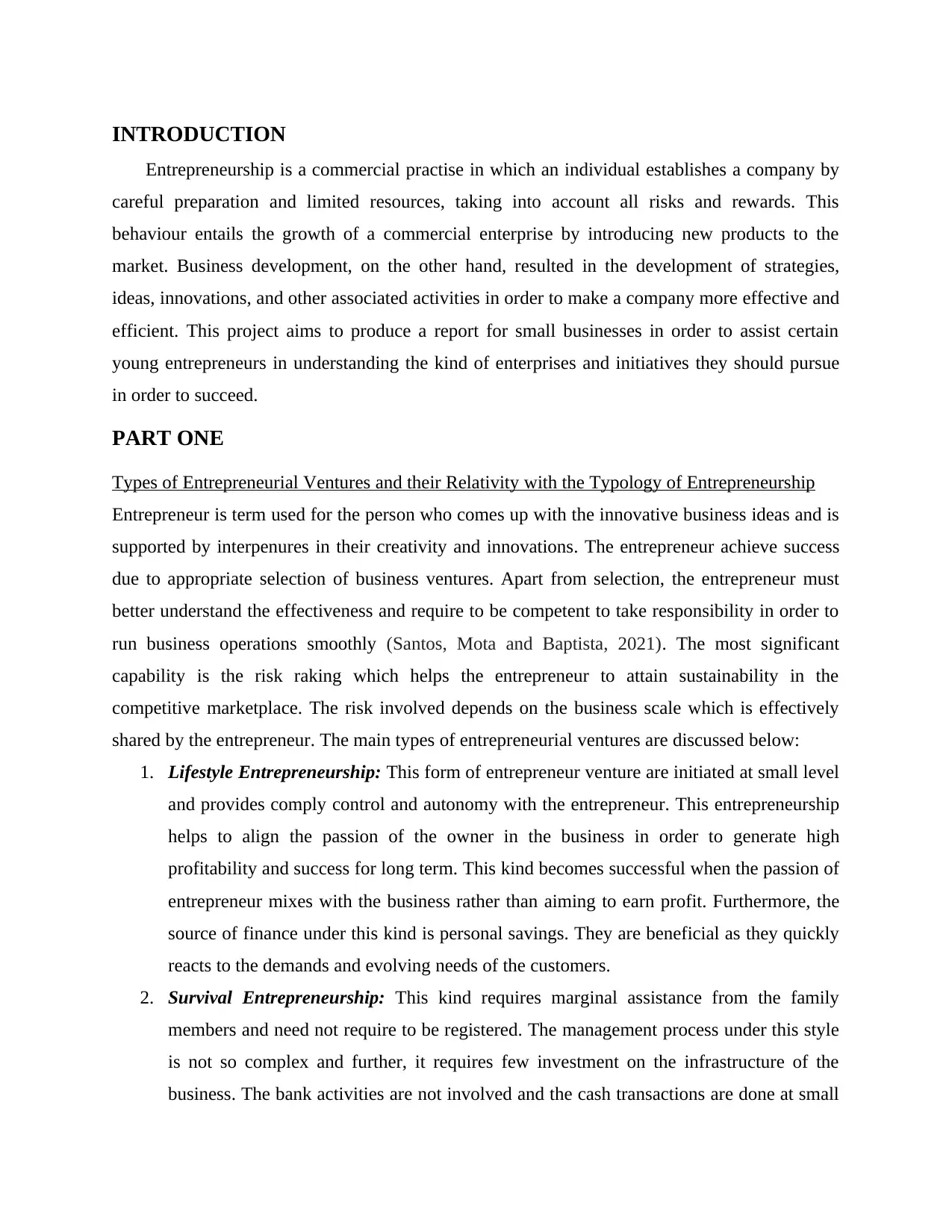
INTRODUCTION
Entrepreneurship is a commercial practise in which an individual establishes a company by
careful preparation and limited resources, taking into account all risks and rewards. This
behaviour entails the growth of a commercial enterprise by introducing new products to the
market. Business development, on the other hand, resulted in the development of strategies,
ideas, innovations, and other associated activities in order to make a company more effective and
efficient. This project aims to produce a report for small businesses in order to assist certain
young entrepreneurs in understanding the kind of enterprises and initiatives they should pursue
in order to succeed.
PART ONE
Types of Entrepreneurial Ventures and their Relativity with the Typology of Entrepreneurship
Entrepreneur is term used for the person who comes up with the innovative business ideas and is
supported by interpenures in their creativity and innovations. The entrepreneur achieve success
due to appropriate selection of business ventures. Apart from selection, the entrepreneur must
better understand the effectiveness and require to be competent to take responsibility in order to
run business operations smoothly (Santos, Mota and Baptista, 2021). The most significant
capability is the risk raking which helps the entrepreneur to attain sustainability in the
competitive marketplace. The risk involved depends on the business scale which is effectively
shared by the entrepreneur. The main types of entrepreneurial ventures are discussed below:
1. Lifestyle Entrepreneurship: This form of entrepreneur venture are initiated at small level
and provides comply control and autonomy with the entrepreneur. This entrepreneurship
helps to align the passion of the owner in the business in order to generate high
profitability and success for long term. This kind becomes successful when the passion of
entrepreneur mixes with the business rather than aiming to earn profit. Furthermore, the
source of finance under this kind is personal savings. They are beneficial as they quickly
reacts to the demands and evolving needs of the customers.
2. Survival Entrepreneurship: This kind requires marginal assistance from the family
members and need not require to be registered. The management process under this style
is not so complex and further, it requires few investment on the infrastructure of the
business. The bank activities are not involved and the cash transactions are done at small
Entrepreneurship is a commercial practise in which an individual establishes a company by
careful preparation and limited resources, taking into account all risks and rewards. This
behaviour entails the growth of a commercial enterprise by introducing new products to the
market. Business development, on the other hand, resulted in the development of strategies,
ideas, innovations, and other associated activities in order to make a company more effective and
efficient. This project aims to produce a report for small businesses in order to assist certain
young entrepreneurs in understanding the kind of enterprises and initiatives they should pursue
in order to succeed.
PART ONE
Types of Entrepreneurial Ventures and their Relativity with the Typology of Entrepreneurship
Entrepreneur is term used for the person who comes up with the innovative business ideas and is
supported by interpenures in their creativity and innovations. The entrepreneur achieve success
due to appropriate selection of business ventures. Apart from selection, the entrepreneur must
better understand the effectiveness and require to be competent to take responsibility in order to
run business operations smoothly (Santos, Mota and Baptista, 2021). The most significant
capability is the risk raking which helps the entrepreneur to attain sustainability in the
competitive marketplace. The risk involved depends on the business scale which is effectively
shared by the entrepreneur. The main types of entrepreneurial ventures are discussed below:
1. Lifestyle Entrepreneurship: This form of entrepreneur venture are initiated at small level
and provides comply control and autonomy with the entrepreneur. This entrepreneurship
helps to align the passion of the owner in the business in order to generate high
profitability and success for long term. This kind becomes successful when the passion of
entrepreneur mixes with the business rather than aiming to earn profit. Furthermore, the
source of finance under this kind is personal savings. They are beneficial as they quickly
reacts to the demands and evolving needs of the customers.
2. Survival Entrepreneurship: This kind requires marginal assistance from the family
members and need not require to be registered. The management process under this style
is not so complex and further, it requires few investment on the infrastructure of the
business. The bank activities are not involved and the cash transactions are done at small
⊘ This is a preview!⊘
Do you want full access?
Subscribe today to unlock all pages.

Trusted by 1+ million students worldwide
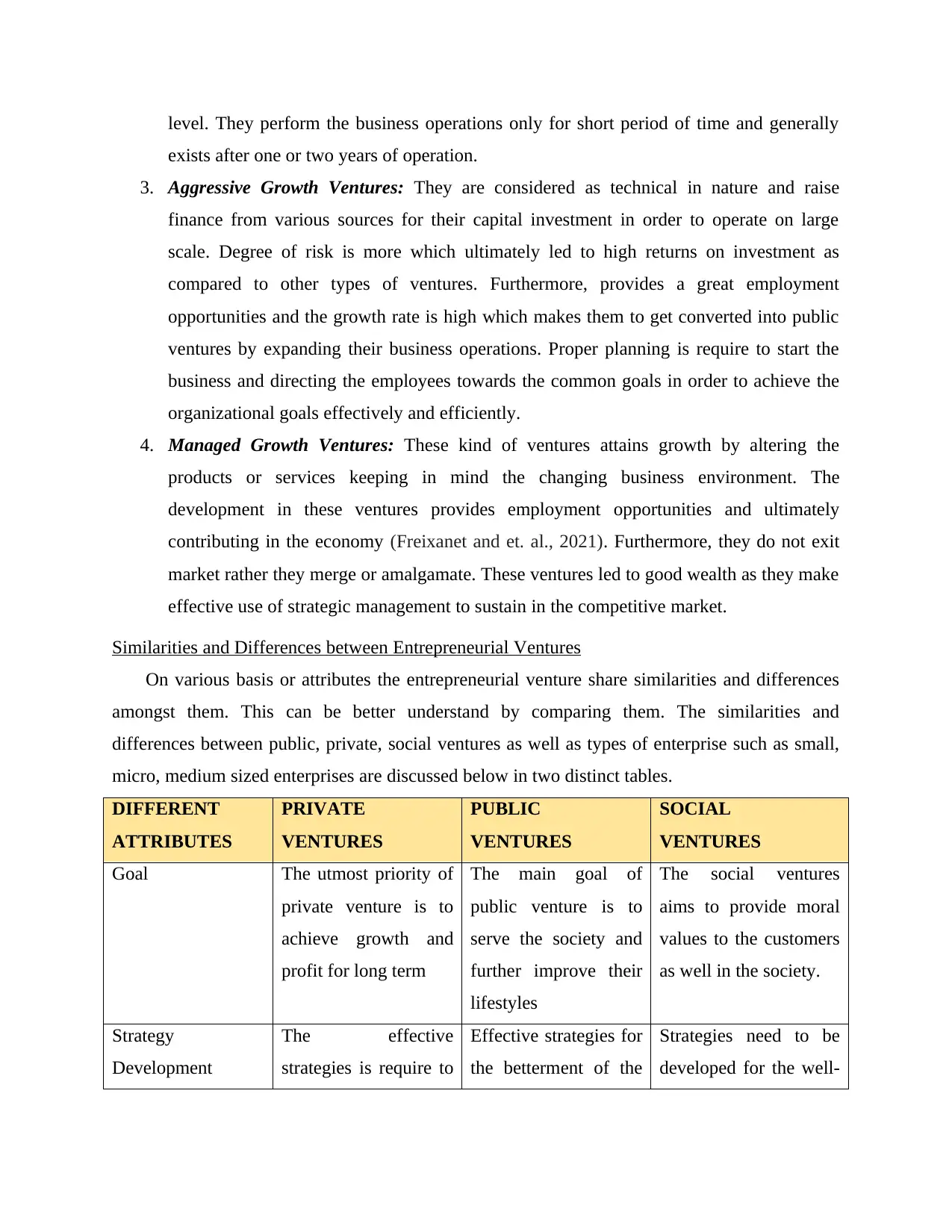
level. They perform the business operations only for short period of time and generally
exists after one or two years of operation.
3. Aggressive Growth Ventures: They are considered as technical in nature and raise
finance from various sources for their capital investment in order to operate on large
scale. Degree of risk is more which ultimately led to high returns on investment as
compared to other types of ventures. Furthermore, provides a great employment
opportunities and the growth rate is high which makes them to get converted into public
ventures by expanding their business operations. Proper planning is require to start the
business and directing the employees towards the common goals in order to achieve the
organizational goals effectively and efficiently.
4. Managed Growth Ventures: These kind of ventures attains growth by altering the
products or services keeping in mind the changing business environment. The
development in these ventures provides employment opportunities and ultimately
contributing in the economy (Freixanet and et. al., 2021). Furthermore, they do not exit
market rather they merge or amalgamate. These ventures led to good wealth as they make
effective use of strategic management to sustain in the competitive market.
Similarities and Differences between Entrepreneurial Ventures
On various basis or attributes the entrepreneurial venture share similarities and differences
amongst them. This can be better understand by comparing them. The similarities and
differences between public, private, social ventures as well as types of enterprise such as small,
micro, medium sized enterprises are discussed below in two distinct tables.
DIFFERENT
ATTRIBUTES
PRIVATE
VENTURES
PUBLIC
VENTURES
SOCIAL
VENTURES
Goal The utmost priority of
private venture is to
achieve growth and
profit for long term
The main goal of
public venture is to
serve the society and
further improve their
lifestyles
The social ventures
aims to provide moral
values to the customers
as well in the society.
Strategy
Development
The effective
strategies is require to
Effective strategies for
the betterment of the
Strategies need to be
developed for the well-
exists after one or two years of operation.
3. Aggressive Growth Ventures: They are considered as technical in nature and raise
finance from various sources for their capital investment in order to operate on large
scale. Degree of risk is more which ultimately led to high returns on investment as
compared to other types of ventures. Furthermore, provides a great employment
opportunities and the growth rate is high which makes them to get converted into public
ventures by expanding their business operations. Proper planning is require to start the
business and directing the employees towards the common goals in order to achieve the
organizational goals effectively and efficiently.
4. Managed Growth Ventures: These kind of ventures attains growth by altering the
products or services keeping in mind the changing business environment. The
development in these ventures provides employment opportunities and ultimately
contributing in the economy (Freixanet and et. al., 2021). Furthermore, they do not exit
market rather they merge or amalgamate. These ventures led to good wealth as they make
effective use of strategic management to sustain in the competitive market.
Similarities and Differences between Entrepreneurial Ventures
On various basis or attributes the entrepreneurial venture share similarities and differences
amongst them. This can be better understand by comparing them. The similarities and
differences between public, private, social ventures as well as types of enterprise such as small,
micro, medium sized enterprises are discussed below in two distinct tables.
DIFFERENT
ATTRIBUTES
PRIVATE
VENTURES
PUBLIC
VENTURES
SOCIAL
VENTURES
Goal The utmost priority of
private venture is to
achieve growth and
profit for long term
The main goal of
public venture is to
serve the society and
further improve their
lifestyles
The social ventures
aims to provide moral
values to the customers
as well in the society.
Strategy
Development
The effective
strategies is require to
Effective strategies for
the betterment of the
Strategies need to be
developed for the well-
Paraphrase This Document
Need a fresh take? Get an instant paraphrase of this document with our AI Paraphraser

gain more profits society being of the people
Distribution of
Profit
Among the
entrepreneur and the
other stakeholders
Among the
stakeholders such as
employees, society,
communities
Distributed among the
society (Weaven and et.
al., 2021).
Source of Finance Debt financing (bank
loans & financial
institutions) or equity
financing (selling
shares)
Revenue is generated
by charging taxes such
as penalty, duty,
income tax and
corporate tax.
Source of revenue is
through donation or
charity.
DIFFERENT
ATTRIBUTES
MICRO SMALL MEDIUM
Planning Short term planning is
done
In order to achieve
goals short term
planning is required
Short term as well as
long term planning is
require to achieve
organizational goals.
Customers The potential
customers belongs to
the native market
Local market
customers are targeted
Customers belonging to
local and national
market are targeted to
achieve desired goals.
Decision Making
Process
Owner has the power
to make decisions
(Blunck, Fetzer and
Tilley, 2021)
Decisions are made by
the owner itself
Owner and other
professional participate
in the company’s
decision making
process
Channel of
Communication
Informal
communication
channel is followed
Informal Process Formal and informal
communication channel
are followed
Distribution of
Profit
Among the
entrepreneur and the
other stakeholders
Among the
stakeholders such as
employees, society,
communities
Distributed among the
society (Weaven and et.
al., 2021).
Source of Finance Debt financing (bank
loans & financial
institutions) or equity
financing (selling
shares)
Revenue is generated
by charging taxes such
as penalty, duty,
income tax and
corporate tax.
Source of revenue is
through donation or
charity.
DIFFERENT
ATTRIBUTES
MICRO SMALL MEDIUM
Planning Short term planning is
done
In order to achieve
goals short term
planning is required
Short term as well as
long term planning is
require to achieve
organizational goals.
Customers The potential
customers belongs to
the native market
Local market
customers are targeted
Customers belonging to
local and national
market are targeted to
achieve desired goals.
Decision Making
Process
Owner has the power
to make decisions
(Blunck, Fetzer and
Tilley, 2021)
Decisions are made by
the owner itself
Owner and other
professional participate
in the company’s
decision making
process
Channel of
Communication
Informal
communication
channel is followed
Informal Process Formal and informal
communication channel
are followed
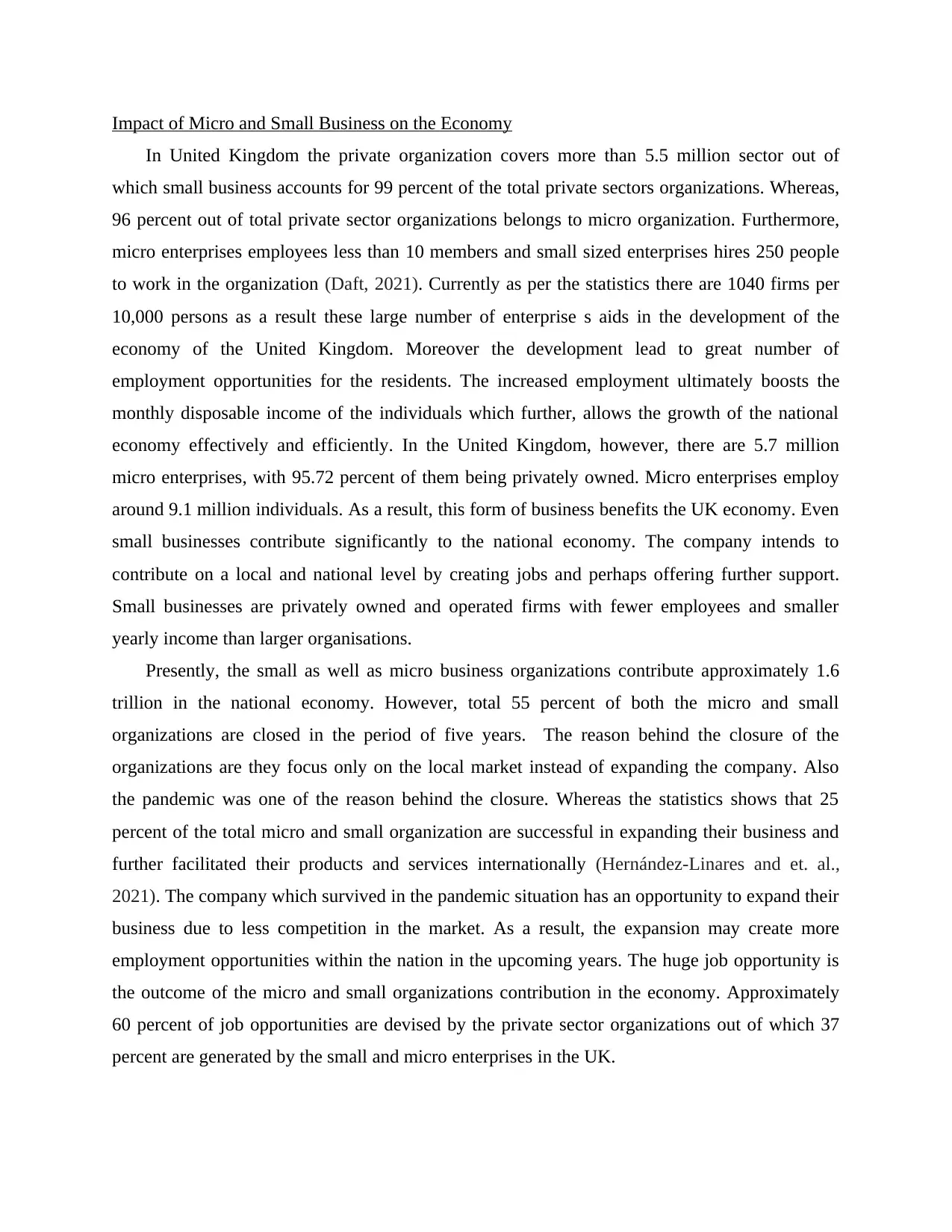
Impact of Micro and Small Business on the Economy
In United Kingdom the private organization covers more than 5.5 million sector out of
which small business accounts for 99 percent of the total private sectors organizations. Whereas,
96 percent out of total private sector organizations belongs to micro organization. Furthermore,
micro enterprises employees less than 10 members and small sized enterprises hires 250 people
to work in the organization (Daft, 2021). Currently as per the statistics there are 1040 firms per
10,000 persons as a result these large number of enterprise s aids in the development of the
economy of the United Kingdom. Moreover the development lead to great number of
employment opportunities for the residents. The increased employment ultimately boosts the
monthly disposable income of the individuals which further, allows the growth of the national
economy effectively and efficiently. In the United Kingdom, however, there are 5.7 million
micro enterprises, with 95.72 percent of them being privately owned. Micro enterprises employ
around 9.1 million individuals. As a result, this form of business benefits the UK economy. Even
small businesses contribute significantly to the national economy. The company intends to
contribute on a local and national level by creating jobs and perhaps offering further support.
Small businesses are privately owned and operated firms with fewer employees and smaller
yearly income than larger organisations.
Presently, the small as well as micro business organizations contribute approximately 1.6
trillion in the national economy. However, total 55 percent of both the micro and small
organizations are closed in the period of five years. The reason behind the closure of the
organizations are they focus only on the local market instead of expanding the company. Also
the pandemic was one of the reason behind the closure. Whereas the statistics shows that 25
percent of the total micro and small organization are successful in expanding their business and
further facilitated their products and services internationally (Hernández-Linares and et. al.,
2021). The company which survived in the pandemic situation has an opportunity to expand their
business due to less competition in the market. As a result, the expansion may create more
employment opportunities within the nation in the upcoming years. The huge job opportunity is
the outcome of the micro and small organizations contribution in the economy. Approximately
60 percent of job opportunities are devised by the private sector organizations out of which 37
percent are generated by the small and micro enterprises in the UK.
In United Kingdom the private organization covers more than 5.5 million sector out of
which small business accounts for 99 percent of the total private sectors organizations. Whereas,
96 percent out of total private sector organizations belongs to micro organization. Furthermore,
micro enterprises employees less than 10 members and small sized enterprises hires 250 people
to work in the organization (Daft, 2021). Currently as per the statistics there are 1040 firms per
10,000 persons as a result these large number of enterprise s aids in the development of the
economy of the United Kingdom. Moreover the development lead to great number of
employment opportunities for the residents. The increased employment ultimately boosts the
monthly disposable income of the individuals which further, allows the growth of the national
economy effectively and efficiently. In the United Kingdom, however, there are 5.7 million
micro enterprises, with 95.72 percent of them being privately owned. Micro enterprises employ
around 9.1 million individuals. As a result, this form of business benefits the UK economy. Even
small businesses contribute significantly to the national economy. The company intends to
contribute on a local and national level by creating jobs and perhaps offering further support.
Small businesses are privately owned and operated firms with fewer employees and smaller
yearly income than larger organisations.
Presently, the small as well as micro business organizations contribute approximately 1.6
trillion in the national economy. However, total 55 percent of both the micro and small
organizations are closed in the period of five years. The reason behind the closure of the
organizations are they focus only on the local market instead of expanding the company. Also
the pandemic was one of the reason behind the closure. Whereas the statistics shows that 25
percent of the total micro and small organization are successful in expanding their business and
further facilitated their products and services internationally (Hernández-Linares and et. al.,
2021). The company which survived in the pandemic situation has an opportunity to expand their
business due to less competition in the market. As a result, the expansion may create more
employment opportunities within the nation in the upcoming years. The huge job opportunity is
the outcome of the micro and small organizations contribution in the economy. Approximately
60 percent of job opportunities are devised by the private sector organizations out of which 37
percent are generated by the small and micro enterprises in the UK.
⊘ This is a preview!⊘
Do you want full access?
Subscribe today to unlock all pages.

Trusted by 1+ million students worldwide
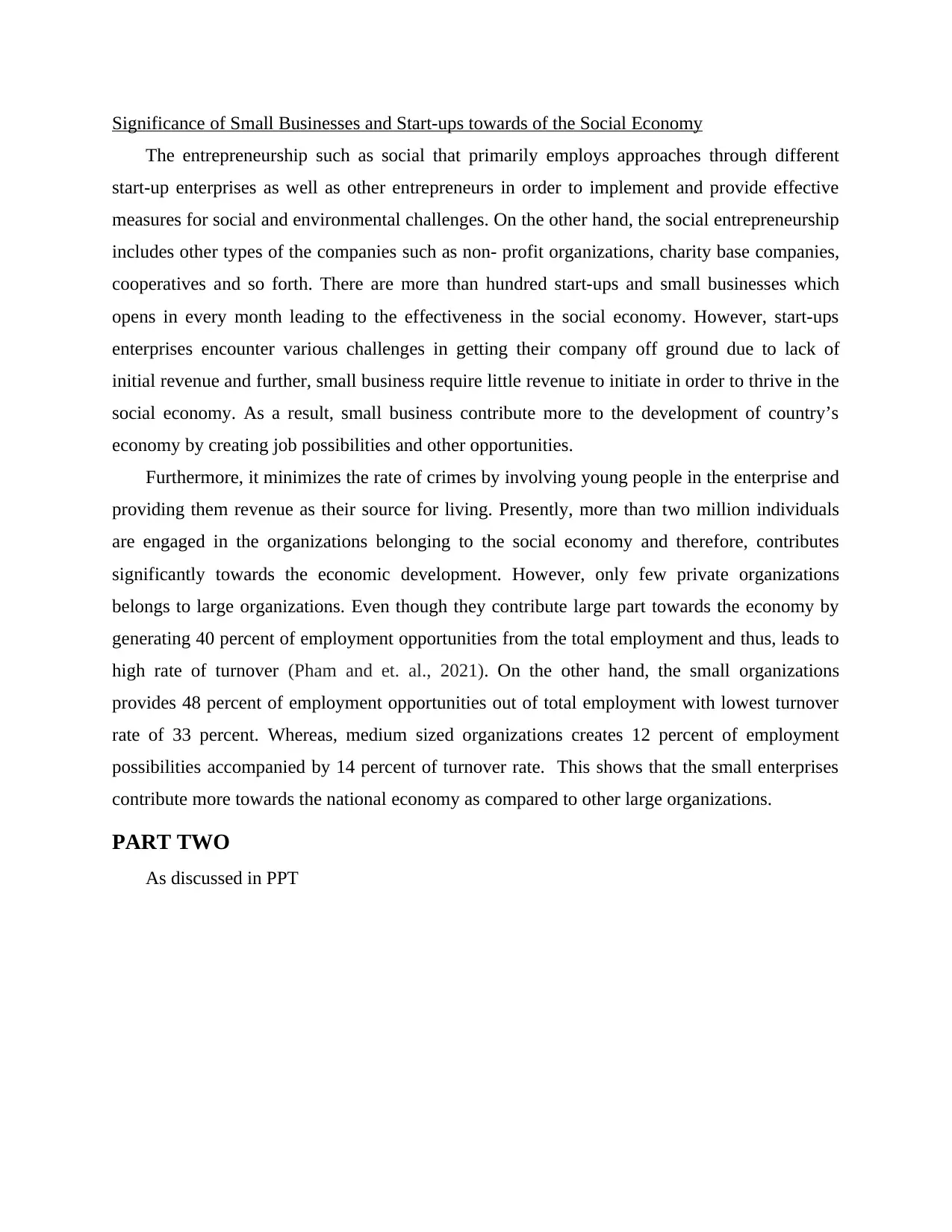
Significance of Small Businesses and Start-ups towards of the Social Economy
The entrepreneurship such as social that primarily employs approaches through different
start-up enterprises as well as other entrepreneurs in order to implement and provide effective
measures for social and environmental challenges. On the other hand, the social entrepreneurship
includes other types of the companies such as non- profit organizations, charity base companies,
cooperatives and so forth. There are more than hundred start-ups and small businesses which
opens in every month leading to the effectiveness in the social economy. However, start-ups
enterprises encounter various challenges in getting their company off ground due to lack of
initial revenue and further, small business require little revenue to initiate in order to thrive in the
social economy. As a result, small business contribute more to the development of country’s
economy by creating job possibilities and other opportunities.
Furthermore, it minimizes the rate of crimes by involving young people in the enterprise and
providing them revenue as their source for living. Presently, more than two million individuals
are engaged in the organizations belonging to the social economy and therefore, contributes
significantly towards the economic development. However, only few private organizations
belongs to large organizations. Even though they contribute large part towards the economy by
generating 40 percent of employment opportunities from the total employment and thus, leads to
high rate of turnover (Pham and et. al., 2021). On the other hand, the small organizations
provides 48 percent of employment opportunities out of total employment with lowest turnover
rate of 33 percent. Whereas, medium sized organizations creates 12 percent of employment
possibilities accompanied by 14 percent of turnover rate. This shows that the small enterprises
contribute more towards the national economy as compared to other large organizations.
PART TWO
As discussed in PPT
The entrepreneurship such as social that primarily employs approaches through different
start-up enterprises as well as other entrepreneurs in order to implement and provide effective
measures for social and environmental challenges. On the other hand, the social entrepreneurship
includes other types of the companies such as non- profit organizations, charity base companies,
cooperatives and so forth. There are more than hundred start-ups and small businesses which
opens in every month leading to the effectiveness in the social economy. However, start-ups
enterprises encounter various challenges in getting their company off ground due to lack of
initial revenue and further, small business require little revenue to initiate in order to thrive in the
social economy. As a result, small business contribute more to the development of country’s
economy by creating job possibilities and other opportunities.
Furthermore, it minimizes the rate of crimes by involving young people in the enterprise and
providing them revenue as their source for living. Presently, more than two million individuals
are engaged in the organizations belonging to the social economy and therefore, contributes
significantly towards the economic development. However, only few private organizations
belongs to large organizations. Even though they contribute large part towards the economy by
generating 40 percent of employment opportunities from the total employment and thus, leads to
high rate of turnover (Pham and et. al., 2021). On the other hand, the small organizations
provides 48 percent of employment opportunities out of total employment with lowest turnover
rate of 33 percent. Whereas, medium sized organizations creates 12 percent of employment
possibilities accompanied by 14 percent of turnover rate. This shows that the small enterprises
contribute more towards the national economy as compared to other large organizations.
PART TWO
As discussed in PPT
Paraphrase This Document
Need a fresh take? Get an instant paraphrase of this document with our AI Paraphraser

CONCLUSION
The above report concludes in two parts, part one examined the different types of
entrepreneurial ventures and their relativity to the typology of entrepreneurship. The report
explored the similarities between different entrepreneurial ventures. Furthermore, the small and
micro as well as start-ups provides great contribution towards the economy of the United
Kingdom. The report highlighted the importance of small business and business start- ups
towards the social economy.
The above report concludes in two parts, part one examined the different types of
entrepreneurial ventures and their relativity to the typology of entrepreneurship. The report
explored the similarities between different entrepreneurial ventures. Furthermore, the small and
micro as well as start-ups provides great contribution towards the economy of the United
Kingdom. The report highlighted the importance of small business and business start- ups
towards the social economy.
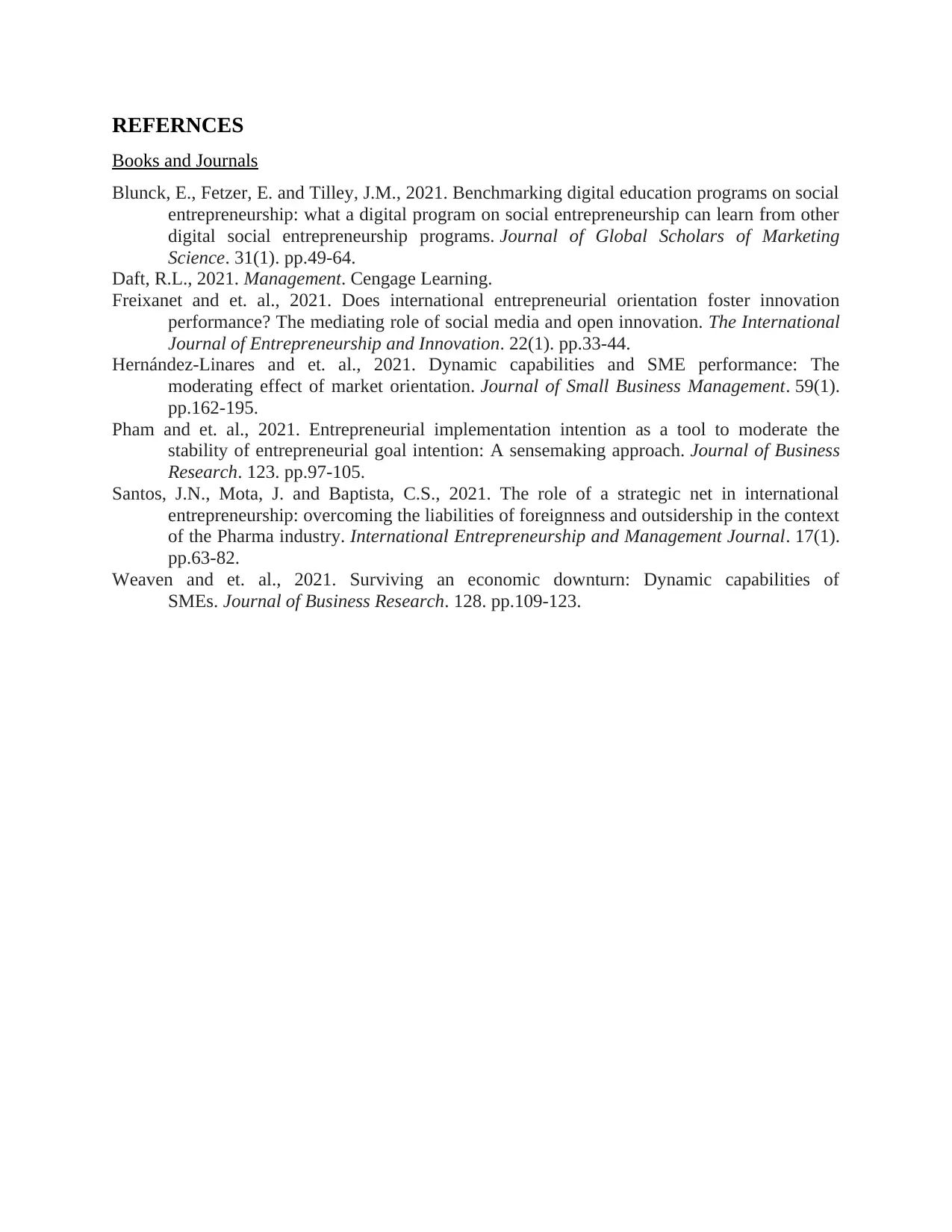
REFERNCES
Books and Journals
Blunck, E., Fetzer, E. and Tilley, J.M., 2021. Benchmarking digital education programs on social
entrepreneurship: what a digital program on social entrepreneurship can learn from other
digital social entrepreneurship programs. Journal of Global Scholars of Marketing
Science. 31(1). pp.49-64.
Daft, R.L., 2021. Management. Cengage Learning.
Freixanet and et. al., 2021. Does international entrepreneurial orientation foster innovation
performance? The mediating role of social media and open innovation. The International
Journal of Entrepreneurship and Innovation. 22(1). pp.33-44.
Hernández-Linares and et. al., 2021. Dynamic capabilities and SME performance: The
moderating effect of market orientation. Journal of Small Business Management. 59(1).
pp.162-195.
Pham and et. al., 2021. Entrepreneurial implementation intention as a tool to moderate the
stability of entrepreneurial goal intention: A sensemaking approach. Journal of Business
Research. 123. pp.97-105.
Santos, J.N., Mota, J. and Baptista, C.S., 2021. The role of a strategic net in international
entrepreneurship: overcoming the liabilities of foreignness and outsidership in the context
of the Pharma industry. International Entrepreneurship and Management Journal. 17(1).
pp.63-82.
Weaven and et. al., 2021. Surviving an economic downturn: Dynamic capabilities of
SMEs. Journal of Business Research. 128. pp.109-123.
Books and Journals
Blunck, E., Fetzer, E. and Tilley, J.M., 2021. Benchmarking digital education programs on social
entrepreneurship: what a digital program on social entrepreneurship can learn from other
digital social entrepreneurship programs. Journal of Global Scholars of Marketing
Science. 31(1). pp.49-64.
Daft, R.L., 2021. Management. Cengage Learning.
Freixanet and et. al., 2021. Does international entrepreneurial orientation foster innovation
performance? The mediating role of social media and open innovation. The International
Journal of Entrepreneurship and Innovation. 22(1). pp.33-44.
Hernández-Linares and et. al., 2021. Dynamic capabilities and SME performance: The
moderating effect of market orientation. Journal of Small Business Management. 59(1).
pp.162-195.
Pham and et. al., 2021. Entrepreneurial implementation intention as a tool to moderate the
stability of entrepreneurial goal intention: A sensemaking approach. Journal of Business
Research. 123. pp.97-105.
Santos, J.N., Mota, J. and Baptista, C.S., 2021. The role of a strategic net in international
entrepreneurship: overcoming the liabilities of foreignness and outsidership in the context
of the Pharma industry. International Entrepreneurship and Management Journal. 17(1).
pp.63-82.
Weaven and et. al., 2021. Surviving an economic downturn: Dynamic capabilities of
SMEs. Journal of Business Research. 128. pp.109-123.
⊘ This is a preview!⊘
Do you want full access?
Subscribe today to unlock all pages.

Trusted by 1+ million students worldwide
1 out of 9
Related Documents
Your All-in-One AI-Powered Toolkit for Academic Success.
+13062052269
info@desklib.com
Available 24*7 on WhatsApp / Email
![[object Object]](/_next/static/media/star-bottom.7253800d.svg)
Unlock your academic potential
Copyright © 2020–2025 A2Z Services. All Rights Reserved. Developed and managed by ZUCOL.




